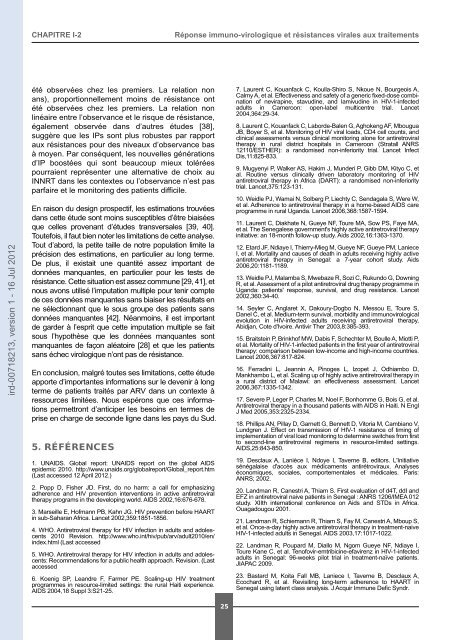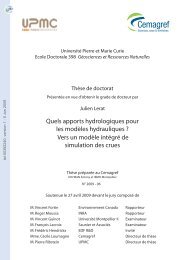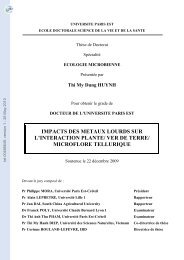CHAPITRE I-2Réponse immuno-virologique et résistances virales aux traitementsird-00718213, version 1 - 16 Jul 2012été observées chez les premiers. La relation nonans), proportionnellement moins de résistance ontété observées chez les premiers. La relation nonlinéaire entre l’observance et le risque de résistance,également observée dans d’autres études [38],suggère que les IPs sont plus robustes par rapportaux résistances pour des niveaux d’observance basà moyen. Par conséquent, les nouvelles générationsd’IP boostées qui sont beaucoup mieux toléréespourraient représenter une alternative de choix auINNRT dans les contextes ou l’observance n’est pasparfaire et le monitoring des patients difficile.En raison du design prospectif, les estimations trouvéesdans cette étude sont moins susceptibles d’être biaiséesque celles provenant d’études transversales [39, 40].Toutefois, il faut bien noter les limitations de cette analyse.Tout d’abord, la petite taille de notre population limite laprécision des estimations, en particulier au long terme.De plus, il existait une quantité assez important dedonnées manquantes, en particulier pour les tests derésistance. Cette situation est assez commune [29, 41], etnous avons utilisé l’imputation multiple pour tenir comptede ces données manquantes sans biaiser les résultats enne sélectionnant que le sous groupe des patients sansdonnées manquantes [42]. Néanmoins, il est importantde garder à l’esprit que cette imputation multiple se faitsous l’hypothèse que les données manquantes sontmanquantes de façon aléatoire [28] et que les patientssans échec virologique n’ont pas de résistance.En conclusion, malgré toutes ses limitations, cette étudeapporte d’importantes informations sur le devenir à longterme de patients traités par ARV dans un contexte àressources limitées. Nous espérons que ces informationspermettront d’anticiper les besoins en termes deprise en charge de seconde ligne dans les pays du Sud.5. RÉFÉRENCES1. UNAIDS. Global report: UNAIDS report on the global AIDSepidemic 2010. http://www.unaids.org/globalreport/Global_report.htm(Last accessed 12 April 2012.)2. Popp D, Fisher JD. First, do no harm: a call for emphasizingadherence and HIV prevention interventions in active antiretroviraltherapy programs in the developing world. AIDS 2002,16:676-678.3. Marseille E, Hofmann PB, Kahn JG. HIV prevention before HAARTin sub-Saharan Africa. Lancet 2002,359:1851-1856.4. WHO. Antiretroviral therapy for HIV infection in adults and adolescents2010 Revision. http://www.who.int/hiv/pub/arv/adult2010/en/index.html (Last accessed5. WHO. Antiretroviral therapy for HIV infection in adults and adolescents:Recommendations for a public health approach. Revision. (Lastaccessed6. Koenig SP, Leandre F, Farmer PE. Scaling-up HIV treatmentprogrammes in resource-limited settings: the rural Haiti experience.AIDS 2004,18 Suppl 3:S21-25.7. Laurent C, Kouanfack C, Koulla-Shiro S, Nkoue N, Bourgeois A,Calmy A, et al. Effectiveness and safety of a generic fixed-dose combinationof nevirapine, stavudine, and lamivudine in HIV-1-infectedadults in Cameroon: open-label multicentre trial. Lancet2004,364:29-34.8. Laurent C, Kouanfack C, Laborde-Balen G, Aghokeng AF, MbouguaJB, Boyer S, et al. Monitoring of HIV viral loads, CD4 cell counts, andclinical assessments versus clinical monitoring alone for antiretroviraltherapy in rural district hospitals in Cameroon (Stratall ANRS12110/ESTHER): a randomised non-inferiority trial. Lancet InfectDis,11:825-833.9. Mugyenyi P, Walker AS, Hakim J, Munderi P, Gibb DM, Kityo C, etal. Routine versus clinically driven laboratory monitoring of HIVantiretroviral therapy in Africa (DART): a randomised non-inferioritytrial. Lancet,375:123-131.10. Weidle PJ, Wamai N, Solberg P, Liechty C, Sendagala S, Were W,et al. Adherence to antiretroviral therapy in a home-based AIDS careprogramme in rural Uganda. Lancet 2006,368:1587-1594.11. Laurent C, Diakhate N, Gueye NF, Toure MA, <strong>Sow</strong> PS, Faye MA,et al. The Senegalese government's highly active antiretroviral therapyinitiative: an 18-month follow-up study. Aids 2002,16:1363-1370.12. Etard JF, Ndiaye I, Thierry-Mieg M, Gueye NF, Gueye PM, LanieceI, et al. Mortality and causes of death in adults receiving highly activeantiretroviral therapy in Senegal: a 7-year cohort study. Aids2006,20:1181-1189.13. Weidle PJ, Malamba S, Mwebaze R, Sozi C, Rukundo G, DowningR, et al. Assessment of a pilot antiretroviral drug therapy programme inUganda: patients' response, survival, and drug resistance. Lancet2002,360:34-40.14. Seyler C, Anglaret X, Dakoury-Dogbo N, Messou E, Toure S,Danel C, et al. Medium-term survival, morbidity and immunovirologicalevolution in HIV-infected adults receiving antiretroviral therapy,Abidjan, Cote d'Ivoire. Antivir Ther 2003,8:385-393.15. Braitstein P, Brinkhof MW, Dabis F, Schechter M, Boulle A, Miotti P,et al. Mortality of HIV-1-infected patients in the first year of antiretroviraltherapy: comparison between low-income and high-income countries.Lancet 2006,367:817-824.16. Ferradini L, Jeannin A, Pinoges L, Izopet J, Odhiambo D,Mankhambo L, et al. Scaling up of highly active antiretroviral therapy ina rural district of Malawi: an effectiveness assessment. Lancet2006,367:1335-1342.17. Severe P, Leger P, Charles M, Noel F, Bonhomme G, Bois G, et al.Antiretroviral therapy in a thousand patients with AIDS in Haiti. N EnglJ Med 2005,353:2325-2334.18. Phillips AN, Pillay D, Garnett G, Bennett D, Vitoria M, Cambiano V,Lundgren J. Effect on transmission of HIV-1 resistance of timing ofimplementation of viral load monitoring to determine switches from firstto second-line antiretroviral regimens in resource-limited settings.AIDS,25:843-850.19. <strong>Desclaux</strong> A, Lanièce I, Ndoye I, <strong>Taverne</strong> B, editors. L'Initiativesénégalaise d'accès aux médicaments antirétroviraux. Analyseséconomiques, sociales, comportementales et médicales. Paris:ANRS; 2002.20. Landman R, Canestri A, Thiam S. First evaluation of d4T, ddI andEFZ in antiretroviral naive patients in Senegal : ANRS 1206/IMEA 012study. XIIth international conference on Aids and STDs in Africa.Ouagadougou 2001.21. Landman R, Schiemann R, Thiam S, Fay M, Canestri A, Mboup S,et al. Once-a-day highly active antiretroviral therapy in treatment-naiveHIV-1-infected adults in Senegal. AIDS 2003,17:1017-1022.22. Landman R, Poupard M, Diallo M, Ngom Gueye NF, Ndiaye I,Toure Kane C, et al. Tenofovir-emtribicine-efavirenz in HIV-1-infectedadults in Senegal: 96-weeks pilot trial in treatment-naïve patients.JIAPAC 2009.23. Bastard M, Koita Fall MB, Laniece I, <strong>Taverne</strong> B, <strong>Desclaux</strong> A,Ecochard R, et al. Revisiting long-term adherence to HAART inSenegal using latent class analysis. J Acquir Immune Defic Syndr.25
CHAPITRE I-2Réponse immuno-virologique et résistances virales aux traitements24. Etard JF, Laniece I, Fall MB, Cilote V, Blazejewski L, Diop K, et al.A 84-month follow up of adherence to HAART in a cohort of adultSenegalese patients. Trop Med Int Health 2007,12:1191-1198.25. Tournoud M, Etard JF, Ecochard R, DeGruttola V. Adherence toantiretroviral therapy, virological response, and time to resistance inthe Dakar cohort. Stat Med,29:14-32.26. Djoko CF, Rimoin AW, Vidal N, Tamoufe U, Wolfe ND, Butel C, etal. High HIV type 1 group M pol diversity and low rate of antiretroviralresistance mutations among the uniformed services in Kinshasa,Democratic Republic of the Congo. AIDS Res HumRetroviruses,27:323-329.27. Gupta RK, Hill A, Sawyer AW, Cozzi-Lepri A, von Wyl V, Yerly S, etal. Virological monitoring and resistance to first-line highly activeantiretroviral therapy in adults infected with HIV-1 treated under WHOguidelines: a systematic review and meta-analysis. Lancet Infect Dis2009,9:409-417.28. Little RJA, Rubin DB. Statistical analysis with missing data: Wiley;2002.ird-00718213, version 1 - 16 Jul 201229. Abraham AG, Lau B, Deeks S, Moore RD, Zhang J, Eron J, et al.Missing data on the estimation of the prevalence of accumulatedhuman immunodeficiency virus drug resistance in patients treated withantiretroviral drugs in north america. Am J Epidemiol,174:727-735.30. Turnbull B. The empirical distribution function with arbitrarilygrouped, censored and truncated data. Journal of the Royal StatisticalSociety 1976,38:290-295.31. Farrington CP. Interval censored survival data: a generalized linearmodelling approach. Stat Med 1996,15:283-292.32. Carstensen B. Regression models for interval censored survivaldata: application to HIV infection in Danish homosexual men. Stat Med1996,15:2177-2189.33. Wood SN. Generalized additive models: an introduction with R:Chapman & Hall/CRC; 2006.34. Efron B, Tibshirani R. An introduction to the bootstrap: Chapman &Hall; 1993.35. Oksendal BK. Stochastic Differential Equations: An IntroductionWith Applications: Springer; 2003.36. R Development Core Team. R: A Language and Environment forStatistical Computing. Vienna: R Foundation for Statistical Computing;2008.37. Laurent C, Kouanfack C, Koulla-Shiro S, Njoume M, Nkene YM,Ciaffi L, et al. Long-term safety, effectiveness and quality of a genericfixed-dose combination of nevirapine, stavudine and lamivudine. AIDS2007,21:768-771.38. Harrigan PR, Hogg RS, Dong WW, Yip B, Wynhoven B, WoodwardJ, et al. Predictors of HIV drug-resistance mutations in a largeantiretroviral-naive cohort initiating triple antiretroviral therapy. J InfectDis 2005,191:339-347.39. Harrigan PR, Wynhoven B, Brumme ZL, Brumme CJ, Sattha B,Major JC, et al. HIV-1 drug resistance: degree of underestimation by across-sectional versus a longitudinal testing approach. J Infect Dis2005,191:1325-1330.40. Pillay D, Green H, Matthias R, Dunn D, Phillips A, Sabin C, EvansB. Estimating HIV-1 drug resistance in antiretroviral-treated individualsin the United Kingdom. J Infect Dis 2005,192:967-973.41. Phillips AN, Dunn D, Sabin C, Pozniak A, Matthias R, Geretti AM,et al. Long term probability of detection of HIV-1 drug resistance afterstarting antiretroviral therapy in routine clinical practice. AIDS2005,19:487-494.42. Rothman KJ, Greenland S, Lash TL. Modern Epidemiology:Wolters Kluwer Health/Lippincott Williams & Wilkins; 2008.26
- Page 1 and 2: ird-00718213, version 1 - 16 Jul 20
- Page 3 and 4: ird-00718213, version 1 - 16 Jul 20
- Page 5 and 6: ird-00718213, version 1 - 16 Jul 20
- Page 7 and 8: Evaluation de l’impact bio-cliniq
- Page 9 and 10: ird-00718213, version 1 - 16 Jul 20
- Page 11 and 12: Evaluation de l’impact bio-cliniq
- Page 13 and 14: ird-00718213, version 1 - 16 Jul 20
- Page 15 and 16: ird-00718213, version 1 - 16 Jul 20
- Page 17 and 18: CHAPITRE I-1Mortalité : incidence,
- Page 19 and 20: CHAPITRE I-1Mortalité : incidence,
- Page 21 and 22: CHAPITRE I-1Mortalité : incidence,
- Page 23 and 24: CHAPITRE I-1Mortalité : incidence,
- Page 25 and 26: CHAPITRE I-1Mortalité : incidence,
- Page 27 and 28: CHAPITRE I-1Mortalité : incidence,
- Page 29 and 30: ird-00718213, version 1 - 16 Jul 20
- Page 31 and 32: CHAPITRE I-2Réponse immuno-virolog
- Page 33: CHAPITRE I-2Réponse immuno-virolog
- Page 37 and 38: CHAPITRE I-2Réponse immuno-virolog
- Page 39 and 40: ird-00718213, version 1 - 16 Jul 20
- Page 41 and 42: CHAPITRE I-3Evénements indésirabl
- Page 43 and 44: CHAPITRE I-3Evénements indésirabl
- Page 45 and 46: ird-00718213, version 1 - 16 Jul 20
- Page 47 and 48: CHAPITRE I-4Vieillissement accélé
- Page 49 and 50: CHAPITRE I-4Vieillissement accélé
- Page 51 and 52: CHAPITRE I-4Vieillissement accélé
- Page 53 and 54: CHAPITRE I-4Vieillissement accélé
- Page 55 and 56: CHAPITRE I-4Vieillissement accélé
- Page 57 and 58: CHAPITRE I-4Vieillissement accélé
- Page 59 and 60: CHAPITRE I-4Vieillissement accélé
- Page 61 and 62: CHAPITRE I-4Vieillissement accélé
- Page 63 and 64: CHAPITRE I-4Vieillissement accélé
- Page 65 and 66: ird-00718213, version 1 - 16 Jul 20
- Page 67 and 68: CHAPITRE II-1Diabète et hypertensi
- Page 69 and 70: CHAPITRE II-1Diabète et hypertensi
- Page 71 and 72: CHAPITRE II-1Diabète et hypertensi
- Page 73 and 74: CHAPITRE II-1Diabète et hypertensi
- Page 75 and 76: CHAPITRE II-1Diabète et hypertensi
- Page 77 and 78: ird-00718213, version 1 - 16 Jul 20
- Page 79 and 80: CHAPITRE II-2Lipodystrophies : pré
- Page 81 and 82: CHAPITRE II-2Lipodystrophies : pré
- Page 83 and 84: CHAPITRE II-2Lipodystrophies : pré
- Page 85 and 86:
CHAPITRE II-2Lipodystrophies : pré
- Page 87 and 88:
CHAPITRE II-2Lipodystrophies : pré
- Page 89 and 90:
ird-00718213, version 1 - 16 Jul 20
- Page 91 and 92:
CHAPITRE II-3Santé sexuelle : étu
- Page 93 and 94:
CHAPITRE II-3Santé sexuelle : étu
- Page 95 and 96:
CHAPITRE II-3Santé sexuelle : étu
- Page 97 and 98:
CHAPITRE II-3Santé sexuelle : étu
- Page 99 and 100:
CHAPITRE II-3Santé sexuelle : étu
- Page 101 and 102:
CHAPITRE II-3Santé sexuelle : étu
- Page 103 and 104:
CHAPITRE II-4L'observance au traite
- Page 105 and 106:
CHAPITRE II-4L'observance au traite
- Page 107 and 108:
CHAPITRE II-4L'observance au traite
- Page 109 and 110:
CHAPITRE II-4L'observance au traite
- Page 111 and 112:
ird-00718213, version 1 - 16 Jul 20
- Page 113 and 114:
ird-00718213, version 1 - 16 Jul 20
- Page 115 and 116:
CHAPITRE III-1De l’expérience de
- Page 117 and 118:
CHAPITRE III-1De l’expérience de
- Page 119 and 120:
CHAPITRE III-1De l’expérience de
- Page 121 and 122:
CHAPITRE III-1De l’expérience de
- Page 123 and 124:
CHAPITRE III-1De l’expérience de
- Page 125 and 126:
ird-00718213, version 1 - 16 Jul 20
- Page 127 and 128:
CHAPITRE III-2Lipodystrophies : per
- Page 129 and 130:
CHAPITRE III-2Lipodystrophies : per
- Page 131 and 132:
CHAPITRE III-2Lipodystrophies : per
- Page 133 and 134:
CHAPITRE III-2Lipodystrophies : per
- Page 135 and 136:
CHAPITRE III-2Lipodystrophies : per
- Page 137 and 138:
CHAPITRE III-2Lipodystrophies : per
- Page 139 and 140:
CHAPITRE III-2Lipodystrophies : per
- Page 141 and 142:
CHAPITRE III-2Lipodystrophies : per
- Page 143 and 144:
CHAPITRE III-2Lipodystrophies : per
- Page 145 and 146:
CHAPITRE III-2Lipodystrophies : per
- Page 147 and 148:
CHAPITRE III-2Lipodystrophies : per
- Page 149 and 150:
CHAPITRE III-2Lipodystrophies : per
- Page 151 and 152:
CHAPITRE III-2Lipodystrophies : per
- Page 153 and 154:
CHAPITRE III-2Lipodystrophies : per
- Page 155 and 156:
CHAPITRE III-3Perception du risque
- Page 157 and 158:
CHAPITRE III-3Perception du risque
- Page 159 and 160:
CHAPITRE III-3Perception du risque
- Page 161 and 162:
CHAPITRE III-3Perception du risque
- Page 163 and 164:
CHAPITRE III-4 Les plaintes et leur
- Page 165 and 166:
CHAPITRE III-4 Les plaintes et leur
- Page 167 and 168:
CHAPITRE III-4 Les plaintes et leur
- Page 169 and 170:
CHAPITRE III-4 Les plaintes et leur
- Page 171 and 172:
CHAPITRE III-4 Les plaintes et leur
- Page 173 and 174:
CHAPITRE III-4 Les plaintes et leur
- Page 175 and 176:
CHAPITRE III-4 Les plaintes et leur
- Page 177 and 178:
CHAPITRE III-4 Les plaintes et leur
- Page 179 and 180:
CHAPITRE III-4 Les plaintes et leur
- Page 181 and 182:
CHAPITRE III-5 Typologie de l’exp
- Page 183 and 184:
CHAPITRE III-5 Typologie de l’exp
- Page 185 and 186:
CHAPITRE III-5 Typologie de l’exp
- Page 187 and 188:
CHAPITRE III-5 Typologie de l’exp
- Page 189 and 190:
ird-00718213, version 1 - 16 Jul 20
- Page 191 and 192:
ird-00718213, version 1 - 16 Jul 20
- Page 193 and 194:
CHAPITRE IV-1Le devenir socio-écon
- Page 195 and 196:
CHAPITRE IV-1Le devenir socio-écon
- Page 197 and 198:
CHAPITRE IV-1Le devenir socio-écon
- Page 199 and 200:
CHAPITRE IV-1Le devenir socio-écon
- Page 201 and 202:
CHAPITRE IV-1Le devenir socio-écon
- Page 203 and 204:
CHAPITRE IV-1Le devenir socio-écon
- Page 205 and 206:
CHAPITRE IV-1Le devenir socio-écon
- Page 207 and 208:
CHAPITRE IV-1Le devenir socio-écon
- Page 209 and 210:
CHAPITRE IV-2Le partage du statut s
- Page 211 and 212:
CHAPITRE IV-2Le partage du statut s
- Page 213 and 214:
CHAPITRE IV-2Le partage du statut s
- Page 215 and 216:
CHAPITRE IV-2Le partage du statut s
- Page 217 and 218:
CHAPITRE IV-2Le partage du statut s
- Page 219 and 220:
CHAPITRE IV-2Le partage du statut s
- Page 221 and 222:
CHAPITRE IV-2Le partage du statut s
- Page 223 and 224:
CHAPITRE IV-2Le partage du statut s
- Page 225 and 226:
CHAPITRE IV-2Le partage du statut s
- Page 227 and 228:
ird-00718213, version 1 - 16 Jul 20
- Page 229 and 230:
CHAPITRE IV-3Le partage de l’info
- Page 231 and 232:
CHAPITRE IV-3Le partage de l’info
- Page 233 and 234:
CHAPITRE IV-3Le partage de l’info
- Page 235 and 236:
CHAPITRE IV-3Le partage de l’info
- Page 237 and 238:
ird-00718213, version 1 - 16 Jul 20
- Page 239 and 240:
CHAPITRE IV-4Les attitudes en mati
- Page 241 and 242:
CHAPITRE IV-4Les attitudes en mati
- Page 243 and 244:
CHAPITRE IV-4Les attitudes en mati
- Page 245 and 246:
CHAPITRE IV-4Les attitudes en mati
- Page 247 and 248:
CHAPITRE IV-4Les attitudes en mati
- Page 249 and 250:
CHAPITRE IV-4Les attitudes en mati
- Page 251 and 252:
ird-00718213, version 1 - 16 Jul 20
- Page 253 and 254:
CHAPITRE VI-5Le mariage, entre souh
- Page 255 and 256:
CHAPITRE VI-5Le mariage, entre souh
- Page 257 and 258:
CHAPITRE VI-5Le mariage, entre souh
- Page 259 and 260:
CHAPITRE VI-5Le mariage, entre souh
- Page 261 and 262:
CHAPITRE VI-5Le mariage, entre souh
- Page 263 and 264:
ird-00718213, version 1 - 16 Jul 20
- Page 265 and 266:
CHAPITRE IV-6L’expérience du veu
- Page 267 and 268:
CHAPITRE IV-6L’expérience du veu
- Page 269 and 270:
CHAPITRE IV-6L’expérience du veu
- Page 271 and 272:
CHAPITRE IV-6L’expérience du veu
- Page 273 and 274:
CHAPITRE IV-6L’expérience du veu
- Page 275 and 276:
CHAPITRE IV-6L’expérience du veu
- Page 277 and 278:
CHAPITRE IV-6L’expérience du veu
- Page 279 and 280:
CHAPITRE IV-6L’expérience du veu
- Page 281 and 282:
CHAPITRE IV-6L’expérience du veu
- Page 283 and 284:
CHAPITRE IV-6L’expérience du veu
- Page 285 and 286:
CHAPITRE IV-6L’expérience du veu
- Page 287 and 288:
CHAPITRE IV-6L’expérience du veu
- Page 289 and 290:
CHAPITRE IV-6L’expérience du veu
- Page 291 and 292:
CHAPITRE IV-7Les personnes âgées
- Page 293 and 294:
CHAPITRE IV-7Les personnes âgées
- Page 295 and 296:
CHAPITRE IV-7Les personnes âgées
- Page 297 and 298:
CHAPITRE IV-7Les personnes âgées
- Page 299 and 300:
CHAPITRE IV-7Les personnes âgées
- Page 301 and 302:
CHAPITRE IV-7Les personnes âgées
- Page 303 and 304:
CHAPITRE IV-7Les personnes âgées
- Page 305 and 306:
ird-00718213, version 1 - 16 Jul 20
- Page 307 and 308:
CHAPITRE V-1Perceptions et prise en
- Page 309 and 310:
CHAPITRE V-1Perceptions et prise en
- Page 311 and 312:
CHAPITRE V-1Perceptions et prise en
- Page 313 and 314:
CHAPITRE V-1Perceptions et prise en
- Page 315 and 316:
CHAPITRE V-1Perceptions et prise en
- Page 317 and 318:
ird-00718213, version 1 - 16 Jul 20
- Page 319 and 320:
CHAPITRE V-2Dispositif institutionn
- Page 321 and 322:
CHAPITRE V-2Dispositif institutionn
- Page 323 and 324:
CHAPITRE V-2Dispositif institutionn
- Page 325 and 326:
CHAPITRE V-2Dispositif institutionn
- Page 327 and 328:
ird-00718213, version 1 - 16 Jul 20
- Page 329 and 330:
CHAPITRE V-3Evolution des coûts ho
- Page 331 and 332:
CHAPITRE V-3Evolution des coûts ho
- Page 333 and 334:
CHAPITRE V-3Evolution des coûts ho
- Page 335 and 336:
CHAPITRE V-3Evolution des coûts ho
- Page 337 and 338:
CHAPITRE V-4Du patient au réseau :
- Page 339 and 340:
CHAPITRE V-4Du patient au réseau :
- Page 341 and 342:
CHAPITRE V-4Du patient au réseau :
- Page 343 and 344:
CHAPITRE V-4Du patient au réseau :
- Page 345 and 346:
CHAPITRE V-4Du patient au réseau :
- Page 347 and 348:
CHAPITRE V-4Du patient au réseau :
- Page 349 and 350:
CHAPITRE V-4Du patient au réseau :
- Page 351 and 352:
CHAPITRE V-4Du patient au réseau :
- Page 353 and 354:
CHAPITRE V-4Du patient au réseau :
- Page 355 and 356:
CHAPITRE V-4Du patient au réseau :
- Page 357 and 358:
CHAPITRE V-4Du patient au réseau :
- Page 359 and 360:
CHAPITRE V-4Du patient au réseau :
- Page 361 and 362:
CHAPITRE V-4Du patient au réseau :
- Page 363 and 364:
CHAPITRE V-4Du patient au réseau :
- Page 365 and 366:
CHAPITRE V-4Du patient au réseau :
- Page 367 and 368:
CHAPITRE V-4Du patient au réseau :
- Page 369 and 370:
CHAPITRE V-5Dispositif expérimenta
- Page 371 and 372:
CHAPITRE V-5Dispositif expérimenta
- Page 373 and 374:
CHAPITRE V-5Dispositif expérimenta
- Page 375 and 376:
CHAPITRE V-5Dispositif expérimenta
- Page 377 and 378:
CHAPITRE V-5Dispositif expérimenta
- Page 379 and 380:
CHAPITRE V-5Dispositif expérimenta
- Page 381 and 382:
CHAPITRE V-5Dispositif expérimenta
- Page 383 and 384:
CHAPITRE V-5Dispositif expérimenta
- Page 385 and 386:
CHAPITRE V-5Dispositif expérimenta
- Page 387 and 388:
CHAPITRE V-5Dispositif expérimenta
- Page 389 and 390:
ird-00718213, version 1 - 16 Jul 20
- Page 391 and 392:
CHAPITRE V-6Mesurer la stigmatisati
- Page 393 and 394:
CHAPITRE V-6Mesurer la stigmatisati
- Page 395 and 396:
CHAPITRE V-6Mesurer la stigmatisati
- Page 397 and 398:
CHAPITRE V-6Mesurer la stigmatisati
- Page 399 and 400:
CHAPITRE V-6Mesurer la stigmatisati
- Page 401 and 402:
CHAPITRE V-6Mesurer la stigmatisati
- Page 403 and 404:
CHAPITRE V-6Mesurer la stigmatisati
- Page 405 and 406:
CHAPITRE V-6Mesurer la stigmatisati
- Page 407 and 408:
ird-00718213, version 1 - 16 Jul 20
- Page 409 and 410:
Evaluation de l’impact bio-cliniq
- Page 411 and 412:
Evaluation de l’impact bio-cliniq
- Page 413 and 414:
Evaluation de l’impact bio-cliniq
- Page 415 and 416:
Evaluation de l’impact bio-cliniq
- Page 417 and 418:
ird-00718213, version 1 - 16 Jul 20
- Page 419 and 420:
ird-00718213, version 1 - 16 Jul 20
- Page 421 and 422:
Dans le cadre de cette cohorte, une
- Page 423 and 424:
propriété intellectuelle et la co
- Page 425 and 426:
ird-00718213, version 1 - 16 Jul 20
- Page 427 and 428:
VisiteSUIVI TEXTE SuiviDATE DATE Da
- Page 429 and 430:
ObservanceDate d'entretien ou date
- Page 431 and 432:
Mémoires et thèses réalisés à
- Page 433 and 434:
Publications issues de la cohorte A
- Page 435 and 436:
Publications issues de la cohorte A
- Page 437 and 438:
Publications issues de la cohorte A
- Page 439:
ird-00718213, version 1 - 16 Jul 20
















